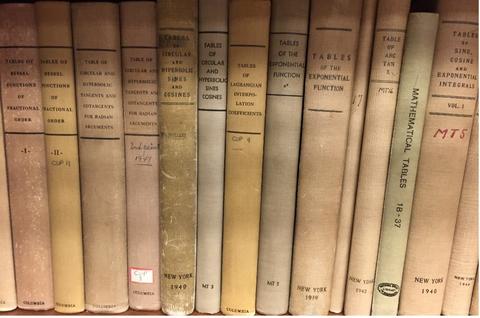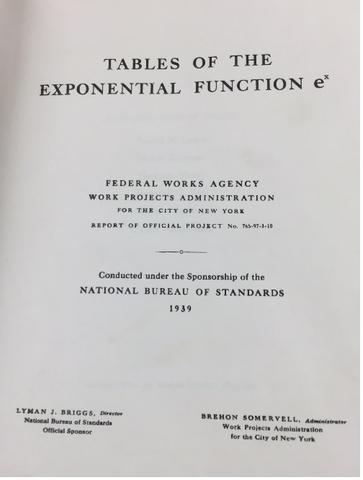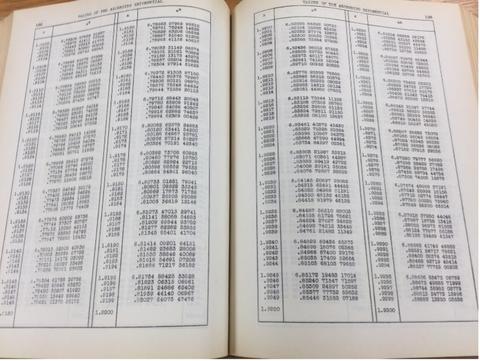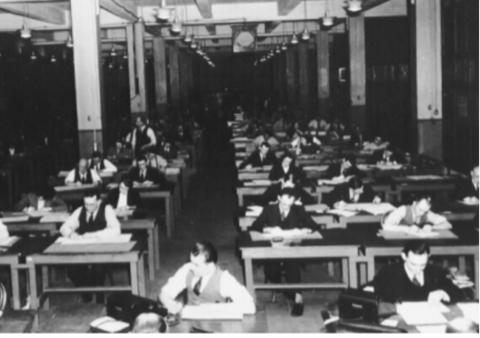Prehistory: The Math Tables Project
Dates: 1938-46
The Math Tables Project (MTP) of the New Deal’s Works Projects Administration (WPA) helped put people to work by having them serve as (human) computers constructing tables of mathematical functions which were needed for hand computation. The project was located in New York City. Thirty-seven volumes of tables for trigonometric functions, exponentials, logarithms, and so on were produced.
After a long search, Arnold Lowan, who taught math and physics at Yeshiva University and Brooklyn College was identified to lead the project. Lowan was a Romanian who immigrated to the US fleeing anti-Semitic pogroms.
One of Lowan’s first recruits was Gertrude Blanch, who was a student in his night course on relativity at Brooklyn College. He noticed that Blanche’s assignments were of much higher quality than his other students. In fact, she already had a PhD in mathematics. She was unable to find professional employment as a mathematician and was trying to maintain her math skills. She would serve as the chief mathematician on the project.
NBS supported Lowan, Blanch and a small group of mathematicians to run the project and provided funds for facilities and equipment. Only a small number of adding machines were obtained, all used, most of which had to be refurbished. These were not used by the bulk of the project’s “computers,” but instead by the project leads for tasks such as computing initial values for the computation and for verifying results.
Most of the actual computations were done by human computers paid for by the WPA. The project grew to be the largest computing organization in the world, with a staff of some 450 persons at its high point.

The Planning Committee (led by Blanch) created algorithms for use of the computers who were given worksheets. The computers were largely unskilled. Most just did addition, fewer subtraction, fewer yet (1-digit) multiplication, and just 1-2 people did division. For example, the computers did not understand negative numbers, so a system of black and red pencils were used. Sign on the wall said
Black + black = black
Red + red = red
Black + red or red + black: hand the sheets to Group 2
Even though it continually produced high quality results, the project failed to gain much respect in the scientific community. The stigma associated with relief work was very strong. Respect for the group increased when Cornelius Lanczos, a Hungarian mathematician/physicist who had worked on relativity theory with Einstein, became a member of the computation planning committee.
Lowan worked to promote the Math Tables Project as a general-purpose computing office for the nation. He was moderately successful in generation additional work.
The WPA terminated the project in early 1943, which led to downsizing and relocation in NYC. Lowan worked hard to identify paid tasks associated with the war effort to keep the project going. Some of those efforts included producing additional tables of mathematical functions, such as Bessel, Struve, Confluent Hypergeometric Functions, but also tables for specialized applications such as LORAN tables (air navigation), ballistics tables, optimal bombing strategies to clear minefields, and even calculations for the Manhattan Project (though participants did not know what they were computing for such top-secret work).
While the MTP remained funded by the Navy after the war, human computers were beginning to lose the edge to automatic computers.
References
- David Alan Grier. The Math Tables Project: The Reluctant Start of the Computing Era. IEEE Annals of the History of Computing 20, Issue 3, July-September 1998, 33-50. DOI: 10.1109/85.707573
- David Alan Grier. When Computers Were Human. Princeton University Press, 2007.





